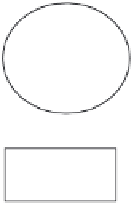Geoscience Reference
In-Depth Information
On these broad lines the scheme is acceptable to all, although changes
in detail could be introduced, for example for distinguishing the humic
substances according to their stability. In a broad sense,
humus
in the
figure corresponds to the set of compartments that are outlined by
solid lines. In accordance with ecological conditions and land use these
compartments are larger or smaller and the fluxes (arrows) thicker or
thinner. Under cropping, the litter compartment is almost empty. The
numbers only represent an order of magnitude. Models, supported by
field measurements and laboratory experiments, are aimed at refining
the scheme and possibly to make predictions according to local ecological
conditions. See
Geoderma
,
81
(1-2), 1997.
Fresh litter
: 50-80% of
annual additions to the
soil
Mineralization: CO , H O,
etc. Up to 55-70% of
annual additions to the soil
2
2
Roots
:
20-50%
of the
additions
Labile fraction
: 1/4
to 1/3 of SOM
Microbial
products
: 1% to
4% of SOM
Resistant
fraction
: lignin,
waxes, phenols;
2/3 to 3/4 of SOM
-1
Humic
substances
Leaching: 200-400 kg
ha
-1
-1
y
Fig. 2.20
Evolution of organic substances in soils.
The degradation of organic materials can be viewed as the reverse
of photosynthesis, which uses CO
2
of the air to synthesize plant
compounds.
Attention of investigators has also been drawn to dissolved organic
matter (DOM). The substances have the same origins as the organic
compounds found in the solid phase. They represent the mobile
phase capable of transporting carbon from the donor horizons to the
accumulation horizons. A bibliographic review (Kalbitz
et al.
2000) is
available.


















